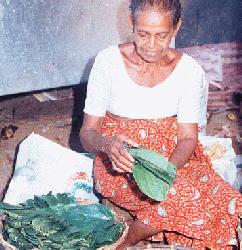




Over the ages the betel leaf has been an integral part of the Eastern life, and still it has its important place. Chamintha Tilakaratne traces the history of the sacred leaf and the survival struggle of a vendor
 Sudu Amma earns about 40 Rs. a day
Sudu Amma earns about 40 Rs. a day
Sixty two year old T.Guneratna, a wiry and wizened woman known as 'Sudu
Amma' among the rest of the vegetable and fruit sellers, can be found every day
in a corner of the bustling Pettah market surrounded by large bundles of betel
leaves. Having travelled all the way from Udamulla in Padukka to Pettah, she is
anxious for some custom. Hers is an arduous day for she goes to the Padukka
market long before sunrise to buy the fresh betel and then arrives in Pettah by
lorry around three a.m to secure her nook at the marketplace.
"I have a mentally affected daughter who's receiving treatment at the hospital. Her daughter, that is my grand daughter has sat for her A/L examination for the second time and lacks five marks to enter university. Her parents are separated. So I am the only one she has. I spend for all her needs with whatever money I obtain by selling these betel leaves," Sudu Amma said.
She has been selling betel at the Pettah market for the past ten years and through experience she has learnt not to get disheartened by the low sales, which is why she enthusiastically awaits the 'Avurudu' season. Her expectations are high, not because of the joy of the dawning of a new season but because it is during this time of year that she records her best sales. The offering of betel holds much significance in the New Year customs and it is one custom that every one regardless of class or creed follows.
The history of the betel leaf goes back to the times of the earliest of the Buddhas and it is believed to have been brought from the 'Naga Lokaya' to earth by the 'Nagaraja ' known as Muchalinda. Betel which is known as bhulath in Sinhalese is said to be a corruption of ' bhoo-lath', meaning received from the earth or the 'Nagalokaya'.
There is much traditional significance related to the offering of betel leaf, though it gained prominence only in the Kandyan period (1480-1815). "In Ayurvedic medicines it holds special reference with rich connotations. Traditionally it stands as a 'Mangala sign' or as a symbol of prosperity," says former Minister of Culture V.J.M.Lokubandara. Although the traditional 'bhulath atha' contains around 40 betel leaves, today the number has been reduced to 20 leaves. The offering of betel leaves to elders on the New Year day is symbolic of humility and the respect and pride one has towards one's elders. It is usually given with the end of the betel leaf turned onto the side of the offerer. This is because of the prominent myth that when Nagaraju Muchlinda was bringing the betel leaf to earth a snake's mouth had touched the ends of the leaf, which is why, even today one sees that all betel chewers break the ends of the betel leaf before chewing, supposedly to clear it of any poison.
The betel leaf also stands for the renewal of time and it represents infinity according to some historians. It is a sign of friendship which is why the villagers tend to exchange betel leaves at special events. Even the custom known as 'ganu-denu' is not complete without it. People do not involve themselves in the first exchange of money for the New Year unless it is given in a betel leaf.
With the betel leaf thus occupying an important place in the customs and traditions of Sri Lanka, especially at the Sinhalese New Year, this is one of the rare occasions when the humble betel seller is much sought after. The rest of the year the sales are low, according to Sudhu Amma, with prices plummeting to as little as Rs 2 per 'bulath atha" in some seasons. These past few days she is able to sell at Rs 12.
For a thousand betel leaves, she gets an income of around 40 rupees on certain days. Hardly adequate, one would imagine considering that she has to pay a rent of fifty rupees for her place at the market. "The number of betel chewers has also decreased over the years," Sudhu Amma stated sadly, "and people generally don't come to buy betel unless there is a special occasion." Usually according to custom one set of betel leaves is exchanged only once, but today even that is changing, she comments. With such a meagre profit it is not surprising that one rarely comes across a betel seller out of season.
The New Year also sees the onset of fierce competition for the likes of Sudu Amma from the seasonal sellers. But this year, she says she has not been affected so badly since there is a lack of betel leaves due to the drought. During the rainy season which usually accompanies the New Year one finds it very difficult to sell betel because there is an excess and people tend to bargain during these seasons.
"There are many days when I have not had any sleep, like today," she claimed, for sleep means to risk the next day's profits. And since her meagre income is as vital to her as the observance of these customs is to so many of us, Sudu Amma will rise early to be at her usual perch, come tomorrow, hoping that the New Year will bring more prosperity.
Continue to Plus page 5 - Understanding Puththandu * New Year forecast * Auspicious Times
Return to the Plus contents page







Please send your comments and suggestions on this web site to
info@suntimes.is.lk or to
webmaster@infolabs.is.lk